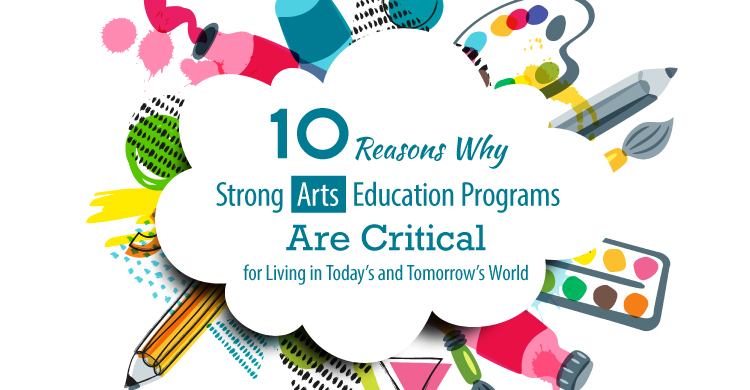Elliott Seif is the author of Teaching for Lifelong Learning: How to Prepare Students for a Changing World.
In two previous blogs, I identified many reasons for building strong science and social studies programs for students, K–12. In this blog, I identify ten key reasons why a comprehensive K–12 arts program should also be a critical component of a rich education that prepares students for living in today’s and tomorrow’s world.
Unfortunately, in too many schools and districts, the arts are considered less important than other subjects and are given short shrift as part of a student’s K–12 educational experience. In my estimation, rich, comprehensive arts programs are a critical component of a strong education because they have a powerful impact on attitudes towards school and learning and help develop important understandings, skills and habits of mind. Arts education programs also develop student interests and talents, prepare students for living a full life and, for some, lead to career choices in music and dance, visual arts, and the theater, among others.
Here are my ten powerful reasons for developing strong, rich, and comprehensive school arts programs.
- Most children like arts education and actively engage in school through the arts.
Let’s face it—for the most part, children like arts education! They are engaged, interested and involved. Arts education is usually “hands on,” has immediate rewards, focuses on positive achievements and results, develops concrete products, and fosters collaboration and successful achievement. There are many opportunities for students to “show off” and demonstrate their skills through authentic performance. For some students, arts education is the main reason why they come to school and stay in school.
- Children learn growth habits, positive behaviors and attitudes through the arts.
The arts enable children to grow in confidence, learn ways to improve learning, and think positively about themselves and learning. Learning a musical instrument, creating a painting, learning to dance, or singing in a chorus teaches that taking small steps, using feedback to improve, practicing to get better at something, and being persistent and patient even in the face of adversity are important for growth and improvement. In other words, the arts teach growth habits, behaviors, and attitudes that can be applied to any field of endeavor. - The arts help students develop critical intellectual skills.
The arts foster the learning of critical skills that carry over to learning other subjects and in life. For example, through the arts, children learn to observe (“What do you see in a painting?”); interpret (“How should we play this music?”); see different perspectives (“What is the artist’s perspective? What is your perspective?”); analyze (“What if we take apart this play and study each part separately?”); and synthesize (“How do all the parts of the dance fit together to create a whole?”). -
The arts enhance creativity and creative thinking.
Imagine an art class in which students create an original canvas filled with color and creative use of space; a music class where they develop their own rhythms and music interpretations; a theater class where they create and produce their own interpretation of plays and/or their own original plays. In other words, the arts are a wonderful arena for fostering creative thinking, inventiveness, and originality—important skills to have in a rapidly changing world. - The arts teach students methods for learning language and literacy skills.
As students learn to read musical notes, play an instrument, learn dance steps, create a painting, act in a drama, or interpret a script, they are also building reading skills, learning how to develop new concepts, building new vocabulary, and learning a new language. - The arts help students learn mathematics.
The arts require measurement, number manipulation, and proportional thinking—all of which foster mathematical thinking. Students also learn about patterns (e.g., musical rhythms and dance patterns); spatial and geometric relationships (e.g., visual art patterns); and three-dimensional measurement skills (e.g., making models of clay). - The arts broaden and enrich learning in other subjects.
Artworks provide a visual context for learning about, interpreting, and analyzing historical periods. Music, painting, theater, and dance help literature come alive. Graphic designs and drawings, such as those made by inventors and engineers, complement learning about scientific and technological principles and innovations. - Aesthetic learning is important in its own right.
The arts teach about beauty, proportion, and grace. The power of the arts is in their wondrous ability to give us joy, help us understand tragedy, promote empathy, and make the written word come alive. They help students examine conflict, power, emotion, and life itself. For many, the arts become part of the richness of living over the course of a lifetime. - Artistic talents and interests are nurtured and developed.
Through the arts, many children discover their talents and interests and find a way to do something productive with their life. They develop career interests, talents, and hobbies related to acting, theater production, painting, graphic design, music, dance, sculpture, or creative writing that they will enjoy and use throughout their lives. - The arts teach teamwork and collaboration. Children learn tolerance and understanding of others.
Through the arts, children learn how to work together to achieve great things. For example, they learn how teamwork contributes to a great theater or musical performance, a mural, or a dance. By teaching students how to work and live together, the arts contribute to making schools and the entire community safer and more peaceful.
Implications
In sum, extensive and excellent art education programs foster important and enjoyable learning experiences, positive attitudes toward school and learning, significant learning across many subject areas, creative thinking, teamwork, the understanding of new career options, talent development, and many other learning and life experiences. Arts programs can make a big difference in the life of every child, and every student should have the opportunity to participate in a strong, multidimensional arts program throughout their educational experience. The arts can have a powerful impact on children and learning, and they can make a significant difference in children’s lives. What it takes is commitment, support, understanding, and hard work to make sure the arts are a significant and meaningful part of every school program in the country.






